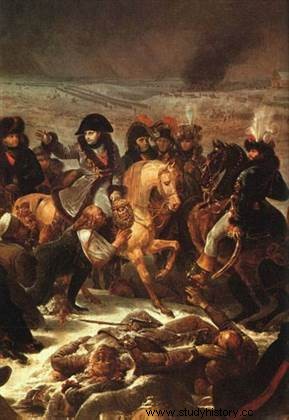 The Battle of Eylau (February 8, 1807) is a hard-won victory for Napoleon I over the Russians in the former East Prussia. It is a real carnage where Napoleon I discovers for the first time the immensity of Russia and the harshness of its winters. He will need victory at the Battle of Friedland, June 14, 1807, for Tsar Alexander I to agree to negotiate. Peace will be made in Tilsit.
The Battle of Eylau (February 8, 1807) is a hard-won victory for Napoleon I over the Russians in the former East Prussia. It is a real carnage where Napoleon I discovers for the first time the immensity of Russia and the harshness of its winters. He will need victory at the Battle of Friedland, June 14, 1807, for Tsar Alexander I to agree to negotiate. Peace will be made in Tilsit.
The Battle of Eylau:Carnage
On September 26, 1806, with English and Russian support as part of the fourth coalition, Frederick William III of Prussia issued an ultimatum to Napoleon I. The latter responded with a lightning war whose culmination, Jena (October 14, 1806), allowed him to enter Poland triumphantly, then to organize the economic blockade of Russia. But, to save Königsberg - where Frederick William III took refuge - and East Prussia, Marshal Bennigsen went against the French.
The battle began on February 8, 1807 in the morning, on the plain of Eylau, in the midst of a storm. Exhausted by eleven days of marching, hampered in their maneuvers and their mobility by snow and mud, the 40,000 Imperial soldiers came up against 60,000 Russians. The charges of Marshals Davout, Murat and Ney eventually push them back. But the Russians withdrew in good order, without real defeat, leaving behind them a mass grave:at least 40,000 dead, tragic heroes who mark the collective memory to the point of inspiring Balzac with the story of Colonel Chabert, buried alive in a mass grave.
Napoleon, testifying to his excitement, only leaves the scene when all the soldiers are buried; then he took up his winter quarters on the Vistula and reorganized his army (supplies, artillery). The latter finally won at Friedland (June 14), a victory leading to the signing of the Treaty of Tilsit (July 7, 1807).
Bibliography
- Eylau (February 8, 1807):The Polish campaign, from the mud of Pultusk to the snows of Eylau by Frédéric Naulet. Economica, 2007.
- Eylau:The battle told by the soldiers of Pierre Robin. 2005.
- Dictionary of Napoleon's Battles:1796-1815 by Alain Pigeard. Tallandier, 2004.
